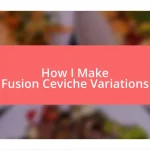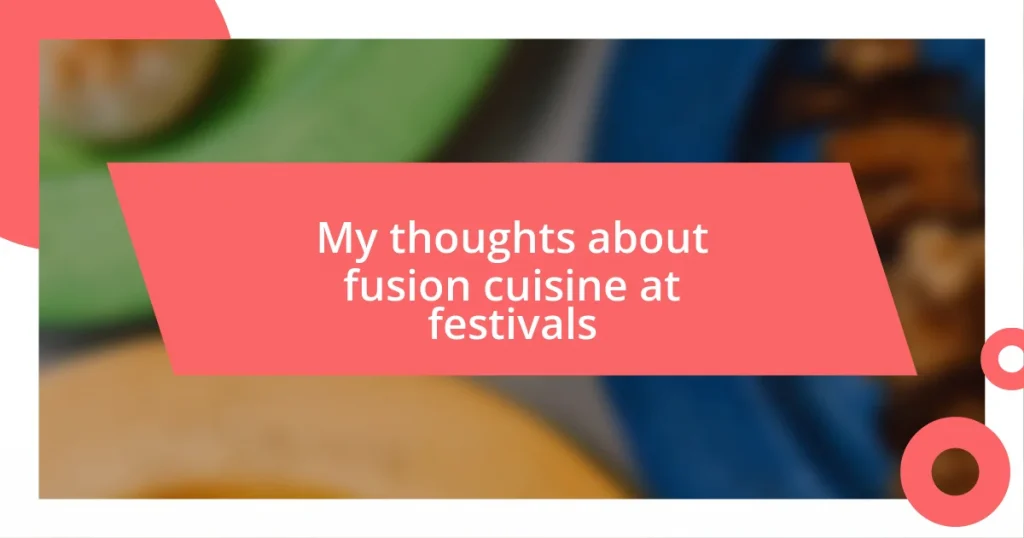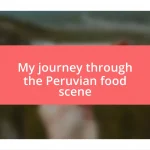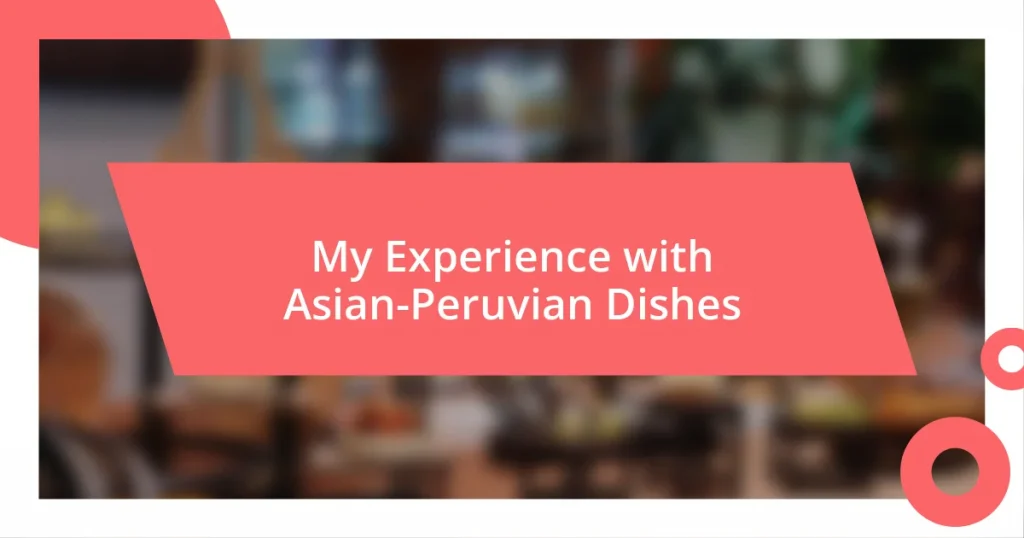Key takeaways:
- Fusion cuisine blends diverse culinary traditions, offering both novelty and a nod to heritage, as seen in dishes like Korean BBQ tacos and Thai pizza.
- Food festivals serve as vibrant platforms for culinary exploration, sparking community connections and shared experiences among attendees.
- Embracing fusion cuisine encourages experimentation and storytelling through food, inspiring both chefs and home cooks to innovate and share their cultural narratives.

Understanding fusion cuisine trends
Fusion cuisine trends have been rapidly evolving, influenced by globalization and the blending of cultures. I remember the first time I tried a Korean taco at a food festival; that moment was a revelation for me! The noteworthy combination of spicy kimchi and savory beef tucked in a soft tortilla truly embodied what fusion cuisine is all about. It’s not just about mixing flavors—it’s about creating renewed culinary experiences.
Interestingly, these trends reflect a broader cultural dialogue. Have you noticed how many people now seek authenticity in their meals while simultaneously craving novelty? I certainly have! At a recent festival, I encountered a chef who artfully combined traditional Italian pasta with Thai green curry—a dish that made my taste buds dance with delight. It exemplified how fusion cuisine can offer both a nod to tradition and a step toward new territories.
Moreover, fusion cuisine often serves as a bridge between communities and cultures. I’ve seen how chefs proudly share their heritage through creative dishes, sparking conversations among festival-goers. It’s fascinating to think about the stories behind each dish—a culinary tale of travels, family recipes, and personal ingredients. It truly makes enjoying food a more enriching experience, doesn’t it?

Festival food culture overview
Festival food culture is a vibrant tapestry woven from diverse culinary traditions. At festivals, food transcends mere sustenance; it’s an opportunity for connection. I recall attending a local fair where I stumbled upon a booth serving fusion sushi burritos. This unique concoction, combining the fresh flavors of sushi with the convenience of a burrito, created such a buzz that people formed a line that stretched around the corner! The excitement was palpable, emphasizing how festival food can unite people through shared experiences.
There’s something magical about the atmosphere at food festivals. The aroma of grilling meats, the sight of colorful dishes, and the cheerful chatter of families and friends create an irresistible allure. I remember savoring some incredible Ethiopian injera topped with a blend of spicy lentils. It wasn’t just a meal; it felt like a celebration of culture right there in my hands. Each bite was rich in history and flavor, making it an unforgettable experience.
While traditional food often carries the weight of heritage, festival cuisine is about experimentation and adventure. Chefs innovate in a way that challenges our expectations and invites us to explore new combinations. I still cherish the memory of a dessert made with coconut cream infused with matcha, layered atop a crispy waffle. It was a thrilling fusion of textures and flavors, reminding me of the endless possibilities that emerge when culture and creativity collide.
| Aspect | Traditional Cuisine | Fusion Cuisine |
|---|---|---|
| Cultural Significance | Preserves heritage and customs | Encourages dialogue and exploration |
| Flavor Profiles | Familiar and comforting | Unpredictable and adventurous |
| Presentation | Classic and well-defined | Innovative and eclectic |

Popular fusion cuisine examples
It’s truly fascinating to see the creativity in fusion cuisine, especially at festivals. I remember tasting a delightful dish called “poutine nachos”—a playful twist on two beloved comfort foods. Picture crispy tortilla chips smothered in gravy, topped with cheese curds and jalapeños. The crunch combined with the gooey richness created an unforgettable flavor explosion that had me coming back for seconds!
Here are some popular examples of fusion cuisine that have made a splash at festivals:
- Korean BBQ Tacos: Savory marinated beef with kimchi in a soft corn tortilla.
- Sushi Burritos: A fusion of sushi and burritos, filled with fresh vegetables, fish, and unique sauces.
- Thai Pizza: Traditional pizza crust topped with spicy peanut sauce, chicken, and fresh cilantro.
- Buffalo Cauliflower Bites: A vegan twist on buffalo wings, combining spicy sauce with crispy cauliflower.
- Churro Ice Cream Sandwich: Fried dough pastry filled with ice cream, blending a popular Mexican dessert with a classic American treat.
Each bite of these dishes encapsulates a playful spirit of culinary exploration that brings strangers together at festivals, reminding us that food is not just for nourishment, but for creating cherished memories.
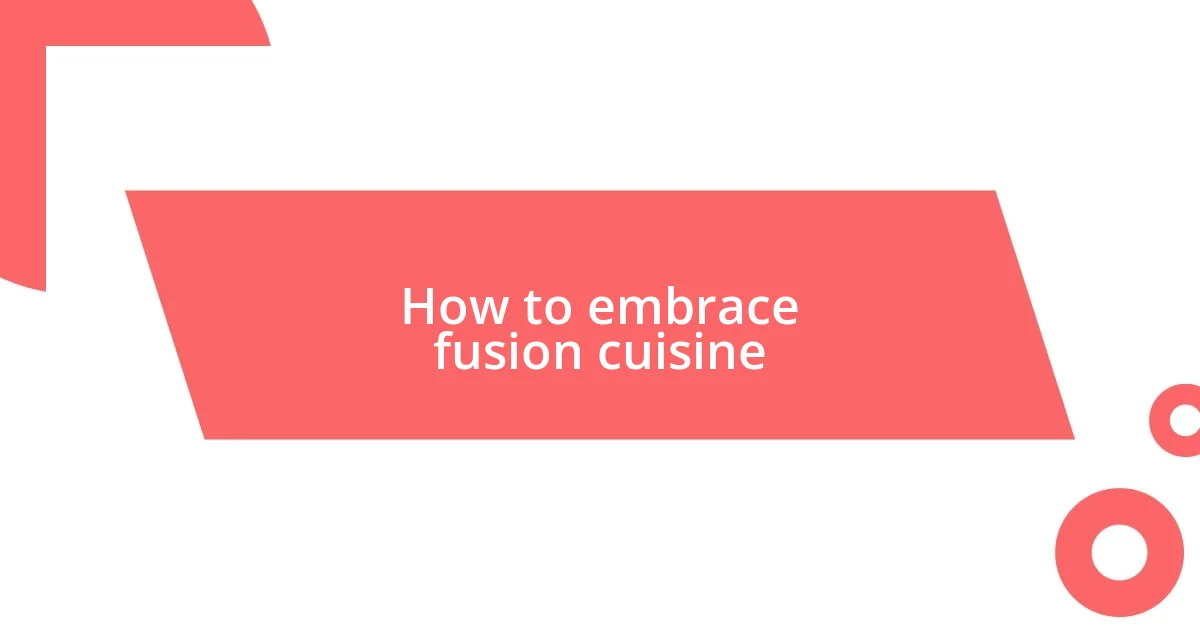
How to embrace fusion cuisine
Embracing fusion cuisine is like opening a door to endless culinary possibilities. One way to start is by being open to trying new combinations that may initially seem outrageous. I vividly remember tasting a dessert that paired spicy jalapeños with chocolate. It was a bold move, but the heat intensified the sweetness, creating a surprisingly delightful experience. Isn’t that something you’d want to explore—how flavors connect in unexpected ways?
When you’re at a festival, take the time to ask the chefs about their inspiration behind their dishes. I once chatted with a vendor who combined Southern BBQ with traditional ramen. His passion made every element of the dish come alive, and he explained how each flavor was a homage to both cultures. Discovering the stories behind fusion dishes adds a layer of connection that elevates the meal into a shared experience. Isn’t that what food should be all about?
Incorporating fusion cuisine into your own cooking can be equally rewarding. I love experimenting by blending ingredients from my heritage with those of other cultures. Once, I made a biryani pizza topped with aromatic spices and fresh herbs. It was a hit at a dinner party—everyone was amazed at how these distinct flavors harmonized beautifully. Isn’t it exciting to think of how you can innovate in your own kitchen, creating dishes that tell your unique story?



